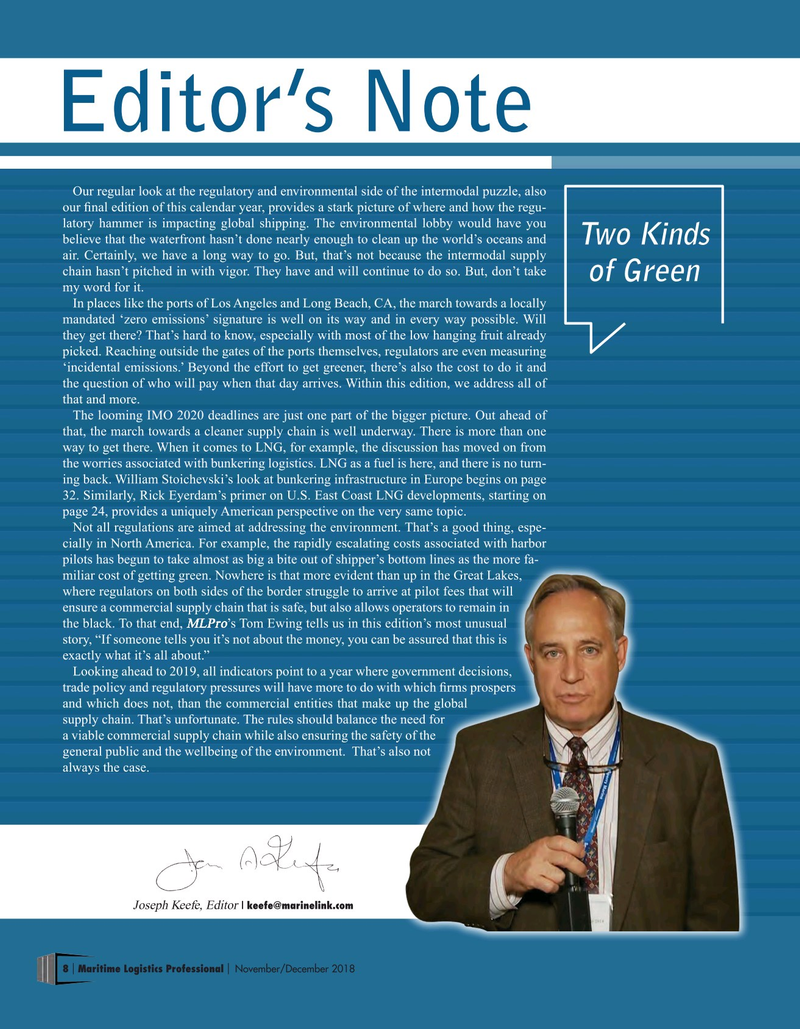
Page 8: of Maritime Logistics Professional Magazine (Nov/Dec 2018)
Regulatory & Environmental Review
Read this page in Pdf, Flash or Html5 edition of Nov/Dec 2018 Maritime Logistics Professional Magazine
Editor’s Note
Our regular look at the regulatory and environmental side of the intermodal puzzle, also our fnal edition of this calendar year, provides a stark picture of where and how the regu- latory hammer is impacting global shipping. The environmental lobby would have you believe that the waterfront hasn’t done nearly enough to clean up the world’s oceans and
Two Kinds air. Certainly, we have a long way to go. But, that’s not because the intermodal supply chain hasn’t pitched in with vigor. They have and will continue to do so. But, don’t take of Green my word for it.
In places like the ports of Los Angeles and Long Beach, CA, the march towards a locally mandated ‘zero emissions’ signature is well on its way and in every way possible. Will they get there? That’s hard to know, especially with most of the low hanging fruit already picked. Reaching outside the gates of the ports themselves, regulators are even measuring ‘incidental emissions.’ Beyond the effort to get greener, there’s also the cost to do it and the question of who will pay when that day arrives. Within this edition, we address all of that and more.
The looming IMO 2020 deadlines are just one part of the bigger picture. Out ahead of that, the march towards a cleaner supply chain is well underway. There is more than one way to get there. When it comes to LNG, for example, the discussion has moved on from the worries associated with bunkering logistics. LNG as a fuel is here, and there is no turn- ing back. William Stoichevski’s look at bunkering infrastructure in Europe begins on page 32. Similarly, Rick Eyerdam’s primer on U.S. East Coast LNG developments, starting on page 24, provides a uniquely American perspective on the very same topic.
Not all regulations are aimed at addressing the environment. That’s a good thing, espe- cially in North America. For example, the rapidly escalating costs associated with harbor pilots has begun to take almost as big a bite out of shipper’s bottom lines as the more fa- miliar cost of getting green. Nowhere is that more evident than up in the Great Lakes, where regulators on both sides of the border struggle to arrive at pilot fees that will ensure a commercial supply chain that is safe, but also allows operators to remain in the black. To that end, MLPro’s Tom Ewing tells us in this edition’s most unusual story, “If someone tells you it’s not about the money, you can be assured that this is exactly what it’s all about.”
Looking ahead to 2019, all indicators point to a year where government decisions, trade policy and regulatory pressures will have more to do with which frms prospers and which does not, than the commercial entities that make up the global supply chain. That’s unfortunate. The rules should balance the need for a viable commercial supply chain while also ensuring the safety of the general public and the wellbeing of the environment. That’s also not always the case.
Joseph Keefe, Editor | [email protected] 8 Maritime Logistics Professional November/December 2018 | |

 7
7

 9
9
